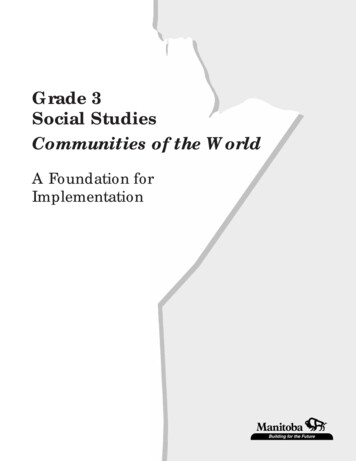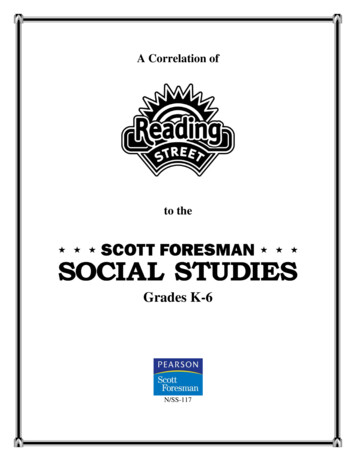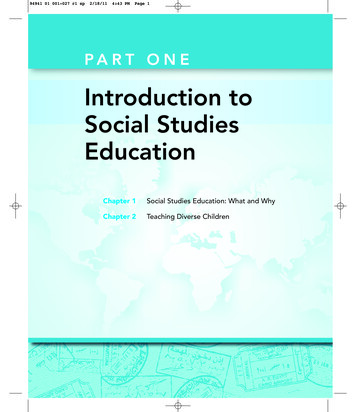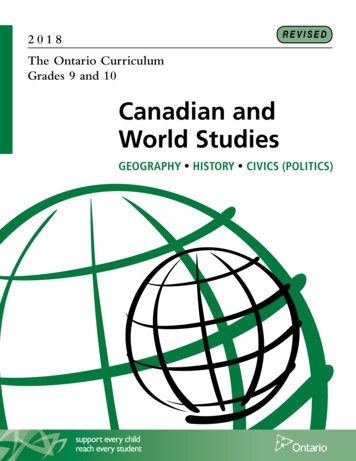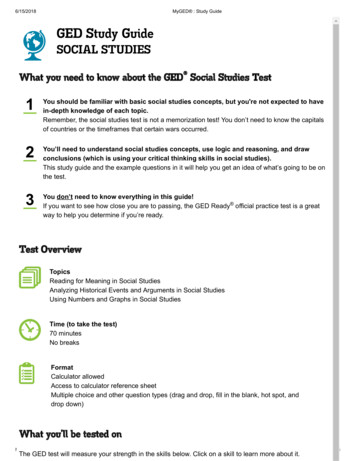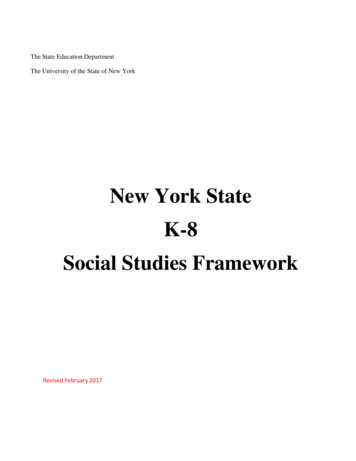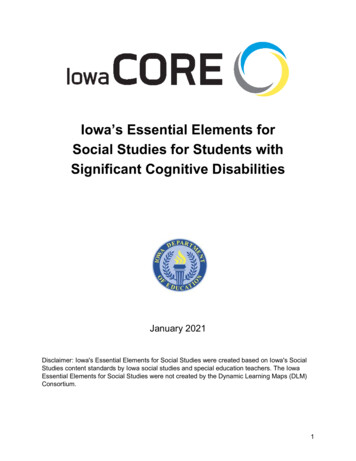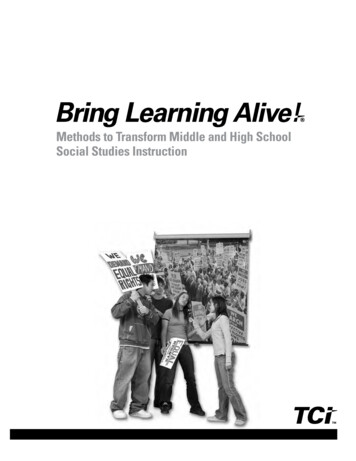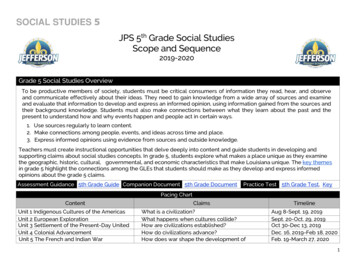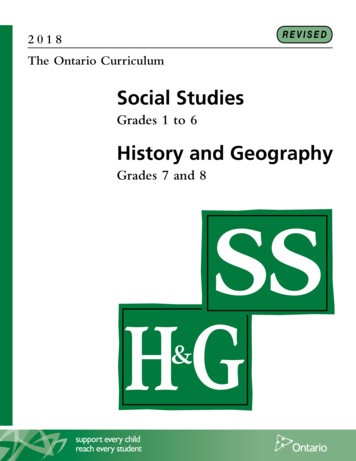
Transcription
REVISED2018The Ontario CurriculumSocial StudiesGrades 1 to 6History and GeographyGrades 7 and 8
The Ontario Public Service endeavours to demonstrate leadership with respect to accessibilityin Ontario. Our goal is to ensure that Ontario government services, products, and facilities areaccessible to all our employees and to all members of the public we serve. This document, orthe information that it contains, is available, on request, in alternative formats. Please forwardall requests for alternative formats to ServiceOntario at 1-800-668-9938 (TTY: 1-800-268-7095).
CONTENTSPREFACE3Elementary Schools for the Twenty-First Century . . . . . . . . . . . . . . . . . . . . . . . . . . . . . . . . . . . . . 3Supporting Students’ Well-Being and Ability to Learn. . . . . . . . . . . . . . . . . . . . . . . . . . . . . . . . . 3INTRODUCTION6The Vision and Goals of the Social Studies, History, and Geography Curriculum . . . . . . . . 6The Importance of Social Studies, History, and Geography in the Curriculum . . . . . . . . . . 9Citizenship Education Framework . . . . . . . . . . . . . . . . . . . . . . . . . . . . . . . . . . . . . . . . . . . . . . . 10Social Studies . . . . . . . . . . . . . . . . . . . . . . . . . . . . . . . . . . . . . . . . . . . . . . . . . . . . . . . . . . . . . . . . . . . . . . 10History . . . . . . . . . . . . . . . . . . . . . . . . . . . . . . . . . . . . . . . . . . . . . . . . . . . . . . . . . . . . . . . . . . . . . . . . . . . . . 11Geography . . . . . . . . . . . . . . . . . . . . . . . . . . . . . . . . . . . . . . . . . . . . . . . . . . . . . . . . . . . . . . . . . . . . . . . . . 12Concepts Underlying the Social Studies, History, and Geography Curriculum . . . . . . . . . 13Indigenous Education in Ontario . . . . . . . . . . . . . . . . . . . . . . . . . . . . . . . . . . . . . . . . . . . . . . . . . . . . 14Roles and Responsibilities in Social Studies, History, and Geography . . . . . . . . . . . . . . . . . 15THE PROGRAM IN SOCIAL STUDIES, HISTORY, AND GEOGRAPHYCurriculum Expectations . . . . . . . . . . . . . . . . . . . . . . . . . . . . . . . . . . . . . . . . . . . . . . . . . . . . . . . . . . . .The Strands in the Social Studies, History, and Geography Curriculum . . . . . . . . . . . . . . . .The Inquiry Process in Social Studies, History, and Geography . . . . . . . . . . . . . . . . . . . . . . . .Spatial Skills: Using Maps, Globes, and Graphs . . . . . . . . . . . . . . . . . . . . . . . . . . . . . . . . . . . . . . .ASSESSMENT AND EVALUATION OF STUDENT ACHIEVEMENT191922232527Basic Considerations. . . . . . . . . . . . . . . . . . . . . . . . . . . . . . . . . . . . . . . . . . . . . . . . . . . . . . . . . . . . . . . . 27The Achievement Chart for Social Studies, History, and Geography . . . . . . . . . . . . . . . . . . . 31SOME CONSIDERATIONS FOR PROGRAM PLANNING IN SOCIAL STUDIES,HISTORY, AND GEOGRAPHYInstructional Approaches . . . . . . . . . . . . . . . . . . . . . . . . . . . . . . . . . . . . . . . . . . . . . . . . . . . . . . . . . . .Cross-Curricular and Integrated Learning. . . . . . . . . . . . . . . . . . . . . . . . . . . . . . . . . . . . . . . . . . . .Planning Social Studies, History, and Geography Programs for Studentswith Special Education Needs . . . . . . . . . . . . . . . . . . . . . . . . . . . . . . . . . . . . . . . . . . . . . . . . . . . . . . .Program Considerations for English Language Learners . . . . . . . . . . . . . . . . . . . . . . . . . . . . .Environmental Education in Social Studies, History, and Geography . . . . . . . . . . . . . . . . . .Une publication équivalente est disponible en français sous le titresuivant : Le curriculum de l’Ontario – Études sociales, de la 1re à la6e année – Histoire et géographie, 7e et 8e année, 2018.This publication is available on the Ministry of Education website,at www.ontario.ca/edu.363639404245
Healthy Relationships and Social Studies, History, and Geography . . . . . . . . . . . . . . . . . . .Equity and Inclusive Education in Social Studies, History, and Geography. . . . . . . . . . . . .Financial Literacy in Social Studies, History, and Geography . . . . . . . . . . . . . . . . . . . . . . . . . .Literacy, Mathematical Literacy, and Inquiry in Social Studies, History,and Geography. . . . . . . . . . . . . . . . . . . . . . . . . . . . . . . . . . . . . . . . . . . . . . . . . . . . . . . . . . . . . . . . . . . . .Critical Thinking and Critical Literacy in Social Studies, History, and Geography . . . . . . .The Role of the School Library in Social Studies, History, and Geography Programs . . . . .The Role of Information and Communications Technology in Social Studies,History, and Geography . . . . . . . . . . . . . . . . . . . . . . . . . . . . . . . . . . . . . . . . . . . . . . . . . . . . . . . . . . . .Education and Career/Life Planning through the Social Studies, History,and Geography Curriculum . . . . . . . . . . . . . . . . . . . . . . . . . . . . . . . . . . . . . . . . . . . . . . . . . . . . . . . . .Health and Safety in Social Studies, History, and Geography . . . . . . . . . . . . . . . . . . . . . . . . .SOCIAL STUDIES, GRADES 1 TO 646474950525455565759The Topics . . . . . . . . . . . . . . . . . . . . . . . . . . . . . . . . . . . . . . . . . . . . . . . . . . . . . . . . . . . . . . . . . . . . . . . . . . 60The Concepts of Social Studies Thinking . . . . . . . . . . . . . . . . . . . . . . . . . . . . . . . . . . . . . . . . . . . . . . . 60The Social Studies Inquiry Process . . . . . . . . . . . . . . . . . . . . . . . . . . . . . . . . . . . . . . . . . . . . . . . . . . . . 63Grade 1Grade 2Grade 3Grade 4Grade 5Grade 6. . . . . . . . . . . . . . . . . . . . . . . . . . . . . . . . . . . . . . . . . . . . . . . . . . . . . . . . . . . . . . . . . . . . . . . . . . . . 65. . . . . . . . . . . . . . . . . . . . . . . . . . . . . . . . . . . . . . . . . . . . . . . . . . . . . . . . . . . . . . . . . . . . . . . . . . . . 75. . . . . . . . . . . . . . . . . . . . . . . . . . . . . . . . . . . . . . . . . . . . . . . . . . . . . . . . . . . . . . . . . . . . . . . . . . . . 85. . . . . . . . . . . . . . . . . . . . . . . . . . . . . . . . . . . . . . . . . . . . . . . . . . . . . . . . . . . . . . . . . . . . . . . . . . . . 97. . . . . . . . . . . . . . . . . . . . . . . . . . . . . . . . . . . . . . . . . . . . . . . . . . . . . . . . . . . . . . . . . . . . . . . . . . 109. . . . . . . . . . . . . . . . . . . . . . . . . . . . . . . . . . . . . . . . . . . . . . . . . . . . . . . . . . . . . . . . . . . . . . . . . . 123HISTORY, GRADES 7 AND 8137The Topics . . . . . . . . . . . . . . . . . . . . . . . . . . . . . . . . . . . . . . . . . . . . . . . . . . . . . . . . . . . . . . . . . . . . . . . . 138The Concepts of Historical Thinking . . . . . . . . . . . . . . . . . . . . . . . . . . . . . . . . . . . . . . . . . . . . . . . . . 138The Historical Inquiry Process . . . . . . . . . . . . . . . . . . . . . . . . . . . . . . . . . . . . . . . . . . . . . . . . . . . . . . 140History, Grade 7 . . . . . . . . . . . . . . . . . . . . . . . . . . . . . . . . . . . . . . . . . . . . . . . . . . . . . . . . . . . . . . . . . . 143History, Grade 8 . . . . . . . . . . . . . . . . . . . . . . . . . . . . . . . . . . . . . . . . . . . . . . . . . . . . . . . . . . . . . . . . . . 155GEOGRAPHY, GRADES 7 AND 8169The Topics . . . . . . . . . . . . . . . . . . . . . . . . . . . . . . . . . . . . . . . . . . . . . . . . . . . . . . . . . . . . . . . . . . . . . . . . 170The Concepts of Geographic Thinking. . . . . . . . . . . . . . . . . . . . . . . . . . . . . . . . . . . . . . . . . . . . . . . 170The Geographic Inquiry Process . . . . . . . . . . . . . . . . . . . . . . . . . . . . . . . . . . . . . . . . . . . . . . . . . . . . 172Geography, Grade 7 . . . . . . . . . . . . . . . . . . . . . . . . . . . . . . . . . . . . . . . . . . . . . . . . . . . . . . . . . . . . . . 175Geography, Grade 8 . . . . . . . . . . . . . . . . . . . . . . . . . . . . . . . . . . . . . . . . . . . . . . . . . . . . . . . . . . . . . . 187APPENDICESA. The Goals of the Additional Subjects in Canadian and World Studies . . . . . . . . . . . . . 199B. Citizenship Education Framework (table) . . . . . . . . . . . . . . . . . . . . . . . . . . . . . . . . . . . . . . . 201C. Map, Globe, and Graphing Skills – A Continuum . . . . . . . . . . . . . . . . . . . . . . . . . . . . . . . . . 203GLOSSARY2211
PREFACEThis document replaces The Ontario Curriculum: Social Studies, Grades 1 to 6; History andGeography, Grades 7 and 8, 2013. Beginning in September 2018 all social studies, history,and geography programs for Grades 1 to 8 will be based on the expectations outlined inthis document.This edition of the curriculum includes a revision of the social studies and historycurriculum,1 developed in collaboration with First Nations, Métis, and Inuit educators,community members, and organizations. The revision was undertaken in response tothe Truth and Reconciliation Commission of Canada’s calls to action numbers 62 and 63.ELEMENTARY SCHOOLS FOR THE TWENTY-FIRST CENTURYOntario elementary schools strive to support high-quality learning while giving everystudent the opportunity to learn in the way that is best suited to their individualstrengths and needs. The Ontario curriculum is designed to help every student reachtheir full potential through a program of learning that is coherent, relevant, and ageappropriate. It recognizes that, today and in the future, students need to be criticallyliterate in order to synthesize information, make informed decisions, communicateeffectively, and thrive in an ever-changing global community. It is important that studentsbe connected to the curriculum, that they see themselves in what is taught, how it is taught,and how it applies to the world at large. The curriculum recognizes that the needs oflearners are diverse and helps all learners develop the knowledge, skills, and perspectivesthey need to become informed, productive, caring, responsible, and active citizens intheir own communities and in the world.SUPPORTING STUDENTS’ WELL-BEING AND ABILITY TO LEARNPromoting the healthy development of all students, as well as enabling all students toreach their full potential, is a priority for educators across Ontario. Students’ health andwell-being contribute to their ability to learn in all disciplines, including social studies,history, and geography, and that learning in turn contributes to their overall well-being.Educators play an important role in promoting children and youth’s well-being bycreating, fostering, and sustaining a learning environment that is healthy, caring, safe,inclusive, and accepting. A learning environment of this kind will support not onlystudents’ cognitive, emotional, social, and physical development but also their sense ofself and spirit, their mental health, their resilience, and their overall state of well-being.All this will help them achieve their full potential in school and in life.1. This revision focused specifically on strands with content pertaining to history. Consequently, there maybe some differences in terminology and style in revised and unrevised strands.3
A variety of factors, known as the “determinants of health”, have been shown to affecta person’s overall state of well-being. Some of these are income, education and literacy,gender and culture, physical and social environment, personal health practices and copingskills, and availability of health services. Together, such factors influence not only whetherindividuals are physically healthy but also the extent to which they have the physical,social, and personal resources needed to cope and to identify and achieve personalaspirations. These factors also have an impact on student learning, and it is importantto be aware of them as factors contributing to a student’s performance and well-being.THE ONTARIO CURRICULUM Social Studies, Grades 1 to 6; History and Geography, Grades 7 and 8An educator’s awareness of and responsiveness to students’ cognitive, emotional, social,and physical development, and to their sense of self and spirit, is critical to their successin school. A number of research-based frameworks, including those described in EarlyLearning for Every Child Today: A Framework for Ontario Early Childhood Settings (2007),On My Way: A Guide to Support Middle Years Child Development (2017), and Stepping Stones:A Resource on Youth Development (2012),2 identify developmental stages that are commonto the majority of students from Kindergarten to Grade 12. At the same time, theseframeworks recognize that individual differences, as well as differences in life experiencesand exposure to opportunities, can affect development, and that developmental eventsare not specifically age-dependent.4The framework described in Stepping Stones is based on a model that illustrates thecomplexity of human development. Its components – the cognitive, emotional, physical,and social domains – are interrelated and interdependent, and all are subject to theinfluence of a person’s environment or context. At the centre is an “enduring (yet changing)core” – a sense of self, or spirit – that connects the different aspects of development andexperience (p. 17).Source: Stepping Stones: A Resource on Youth Development, p. 17.2. B est Start Expert Panel on Early Learning, Early Learning for Every Child Today: A Framework for Ontario EarlyChildhood Settings (2007) is available at um.pdf; Ministryof Children and Youth Services, On My Way: A Guide to Support Middle Years Child Development (2017) is availableat s/middleyears/onmyway/index.aspx; and Governmentof Ontario, Stepping Stones: A Resource on Youth Development (2012) is available at .
Educators who have an awareness of a student’s development take each component intoaccount, with an understanding of and focus on the following elements: cognitive development brain development, processing and reasoning skills, useof strategies for learning emotional development emotional regulation, empathy, motivation social development self-development (self-concept, self-efficacy, self-esteem);identity formation (gender identity, social group identity, spiritual identity);relationships (peer, family, romantic) physical development – physical activity, sleep patterns, changes that come withpuberty, body image, nutritional requirementsThe Role of Mental HealthMental health touches all components of development. Mental health is much morethan the absence of mental illness. Well-being is influenced not only by the absence ofproblems and risks but by the presence of factors that contribute to healthy growth anddevelopment. By nurturing and supporting students’ strengths and assets, educatorshelp promote positive mental health in the classroom. At the same time, they can identifystudents who need additional support and connect them with the appropriate services.3What happens at school can have a significant influence on a student’s well-being. Witha broader awareness of mental health, educators can plan instructional strategies thatcontribute to a supportive classroom climate for learning in all subject areas, buildawareness of mental health, and reduce stigma associated with mental illness. Takingstudents’ well-being, including their mental health, into account when planninginstructional approaches helps establish a strong foundation for learning.PREFACE3. See the ministry document Supporting Minds: An Educator’s Guide to Promoting Students’ Mental Healthand Well-being (2013).5
INTRODUCTIONTHE VISION AND GOALS OF THE SOCIAL STUDIES, HISTORY,AND GEOGRAPHY CURRICULUMThe Grade 1 to 8 social studies, history, and geography curriculum shares a commonvision with the Grade 9 to 12 Canadian and world studies curriculum. That vision andthe goals of the elementary and secondary program are as follows:Vision and Goals for Social Studies, Grades 1 to 6; History and Geography, Grades 7 and 8; andCanadian and World Studies, Grades 9 to 12VisionThe social studies, history, geography, and Canadian and world studies programs will enable studentsto become responsible, active citizens within the diverse communities to which they belong. As well asbecoming critically thoughtful and informed citizens who value an inclusive society, students will havethe skills they need to solve problems and communicate ideas and decisions about significant developments,events, and issues.GoalsIn social studies, history, and geography, and all the subjects in Canadian and world studies, studentsrealize the vision for the program as they: develop the ability to use the “concepts of disciplinary thinking” to investigate issues, events, anddevelopments; develop the ability to determine and apply appropriate criteria to evaluate information and evidenceand to make judgements; develop skills and personal attributes that are needed for discipline-specific inquiry and that can betransferred to other areas in life; build collaborative and cooperative working relationships; use appropriate technology as a tool to help them gather and analyse information, solve problems,and communicate.The chart on the next page outlines how students will achieve the goals in the individualsubjects of this elementary curriculum – social studies, history, and geography4 – andhow these subjects will prepare them to realize the vision of the program.4. T he goals for history and geography in the secondary Canadian and world studies curriculum are thesame as those for history and geography in the elementary curriculum. The goals for the other subjectsin Canadian and world studies can be found in Appendix A on page 199.6
Goals of Social Studies –Developing a sense of who I am,and who we areGoals of History –Developing a sense of timeGoals of Geography –Developing a sense of placeWho are we? Who came before us?Where have I come from? WhatHow have we changed?makes me belong? Where are wenow? How can I contribute to society?What is where, why there, andwhy care?Students will work towards:Students will work towards:Students will work towards: developing an understandingof responsible citizenship; developing an understandingof the diversity within local,national, and global communi ties, both past and present; developing an understandingof interrelationships withinand between the naturalenvironment and humancommunities; developing the knowledge,understanding, and skills thatlay the foundation for futurestudies in geography, history,economics, law, and politics; developing the personalattributes that foster curiosityand the skills that enable themto investigate developments,events, and issues. developing an understandingof past societies, develop ments,and events that enables themto interpret and analysehistorical, as well as current,issues; analysing how people fromdiverse groups have interactedand how they have changedover time; understanding the experiencesof and empathizing withpeople in past societies; developing historical literacyskills by analysing andinterpreting evidence fromprimary and secondary sources. developing an understandingof the characteristics andspatial diversity of natural andhuman environments andcommunities, on a local toa global scale; analysing the connectionswithin and between naturaland human environmentsand communities; developing spatial skillsthrough the use of spatialtechnologies and theinterpretation, analysis, andconstruction of various typesof maps, globes, and graphs; being responsible stewards ofthe Earth by developing anappreciation and respect forboth natural and humanenvironments and communities.Tools and Strategies to Help Achieve the Vision of the ProgramThe following tools and strategies have been incorporated into the curriculum as anecessary part of the learning to help students achieve the vision for learning in socialstudies, history, and geography in the elementary curriculum. The citizenship education framework (see page 10): This framework bringstogether the main elements of citizenship education. The grade and subjectoverviews in the social studies, history, and geography curriculum highlightconnections to specific topics and terms in the framework to enhance opportunitiesfor citizenship education. The concepts of disciplinary thinking (see page 13): These concepts provide away for students to develop the ability to think critically about significant events,developments, and issues, both within the curriculum and in their lives outsidethe classroom.INTRODUCTION The inquiry process (see page 23): Students use the components of the inquiryprocess to investigate, and to communicate their findings about, significant events,developments, and issues. By applying the inquiry process, students developskills that they need in order to think critically, solve problems, make informedjudgements, and communicate ideas.7
Big ideas (see page 14): The big ideas provide context for the overall expectationsand the concepts of disciplinary thinking that are related to them. The big ideasreflect the enduring understandings that students retain from their learning,transfer to other subjects, and draw upon throughout their lives. Framing questions (see the overview charts for each grade/subject): The framingquestions are overarching questions related to the overall expectations and bigideas. They are intended to stimulate students’ critical thinking and to encouragethem to consider the broader relevance of what they are studying. Spatial skills (see page 25): Students use spatial skills and tools to analyse andconstruct various types of maps and graphs. By developing these skills, studentswill be able to understand and analyse visual data and information, contributingto their ability to solve problems.The figure below illustrates the interrelationship between these tools and strategies andthe achievement of expectations in the social studies, history, and geography curriculum.THE ONTARIO CURRICULUM Social Studies, Grades 1 to 6; History and Geography, Grades 7 and 8Connecting the Pieces8
THE IMPORTANCE OF SOCIAL STUDIES, HISTORY, AND GEOGRAPHYIN THE CURRICULUMIn social studies, history, and geography, students develop skills, knowledge andunderstanding, and attitudes that will serve them both inside and outside the classroom,including in their communities and the world of work. The focus of teaching andlearning in the social studies, history, and geography curriculum is the developmentof transferable skills that students need in order to acquire and apply knowledge andunderstanding. Students apply these skills in a variety of contexts to examine informationcritically, to assess the significance of events and processes, to develop an understandingof and respect for different points of view, and to reach supportable conclusions andpropose solutions to problems.Citizenship Education in the Social Studies, History,and Geography CurriculumThe responsible, active citizen participates in their community for the commongood. Citizenship education provides “ways in which young people are preparedand consequently ready and able to undertake their roles as citizens.”Julian Fraillon and Wolfram Schulz, “Concept and Design of the InternationalCivic and Citizenship Study” (2008)Citizenship education is an important facet of students’ overall education. In every gradeand course in the social studies, history, and geography curriculum, students are givenopportunities to learn about what it means to be a responsible, active citizen in the community of the classroom and the diverse communities to which they belong within andoutside the school. It is important for students to understand that they belong to manycommunities and that, ultimately, they are all citizens of the global community.The diagram on page 10 presents a framework for citizenship education. In this figure: the outer circle lists the four main elements of citizenship education – activeparticipation, identity, attributes, and structures – and describes each element; the second circle outlines ways in which students may develop the knowledge,skills, and attitudes associated with responsible citizenship. Teachers should ensurethat students have opportunities to develop these attitudes, understandings, andpractices as they work to achieve the expectations in social studies, history, andgeography (and those in other subjects as well);The citizenship education framework is provided in tabular form in Appendix B.INTRODUCTION the innermost circle lists various terms and topics that are related to citizenshipeducation. Teachers may focus on these terms/topics when making connectionsbetween citizenship education and expectations in the social studies, history, andgeography curriculum as well as those in other curriculum documents. In thefigure, each term/topic in the innermost circle is connected to a specific elementwithin the framework. However, it is important to note that, in practice, a term canbe applied to more than one element – as the dotted lines imply – and that a numberof terms may be woven together in a unit that incorporates citizenship education.9
Citizenship Education Framework Develop an Voice informedopinions on mattersunderstanding ofrelevant to their communitythe importanceof rules and laws Adopt leadership roles in their Develop an understanding ofcommunityhowpolitical, economic, and social Participate in their communityinstitutions affect their lives Investigate controversial issues Develop an understanding Demonstrate collaborative,democracy decision makingof power dynamicsself-determination and voting influence innovative problem solving Develop an understandrules and law conflict resolution Build positiveing of the dynamic andinstitutions power and and peace building relationships withcomplexrelationships authority security systems reconciliation reciprocity diverse individualswithin and betweenadvocacy stewardship and groupsleadership volunteeringsystemsTHE ONTARIO CURRICULUM Social Studies, Grades 1 to 6; History and Geography, Grades 7 and 8inclusiveness equity 10 Explore issuesempathy and respect related to personalrights and responsibilities and societal rightsfreedom social cohesion justice fairness and responsibilitiestruth citizenship Demonstratecollaboration andself-respect, as well ascooperationrespect and empathyfor others Develop attitudes that fostercivic engagement Workin a collaborative andcritically thoughtful mannerinterconnectedness beliefs and values self-efficacy culture perspective community relationships Identify and developtheir sense of connectedness to local,national, and globalcommunities Develop a sense of theircivic self-image Consider and respect others’perspectives Investigate moral andethical dimensionsof developments,events, and issuesThe combination of the citizenship education framework and the knowledge and skills inthe curriculum expectations brings citizenship education to life, not only in social studies, history, and geography, but in many other subjects as well.SOCIAL STUDIES social studies instruction does not merely have students repeat information that theyhave heard or read; rather, it engages them in thinking a
The Ontario Curriculum: Social Studies, Grades 1 to 6; History and Geography, Grades 7 and 8, 2013. Beginning in September 2018 all social studies, history, and geography programs for Grades 1 to 8 will be based on the expectations outlined in this document. This edition of the curriculum includes a revision of the social studies and history
